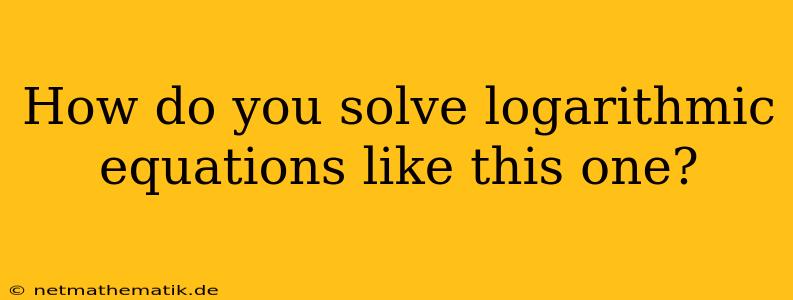Logarithmic equations, like many mathematical problems, require specific steps and techniques to arrive at a solution. Understanding the properties of logarithms is crucial for navigating these equations. This article will guide you through the process of solving logarithmic equations, using a practical example to illustrate each step.
Understanding Logarithmic Equations
Logarithmic equations are mathematical expressions that involve logarithms. Logarithms are the inverse of exponential functions. In simpler terms, a logarithm answers the question: "To what power must we raise the base to get a certain number?" For example, the logarithm of 100 to the base 10 is 2, because 10 raised to the power of 2 equals 100 (10^2 = 100).
Basic Properties of Logarithms
Before tackling logarithmic equations, it's essential to understand the fundamental properties:
- Product Rule: log<sub>a</sub> (x * y) = log<sub>a</sub> x + log<sub>a</sub> y
- Quotient Rule: log<sub>a</sub> (x / y) = log<sub>a</sub> x - log<sub>a</sub> y
- Power Rule: log<sub>a</sub> x<sup>n</sup> = n * log<sub>a</sub> x
- Change of Base Rule: log<sub>a</sub> x = (log<sub>b</sub> x) / (log<sub>b</sub> a)
Solving Logarithmic Equations: A Step-by-Step Guide
Let's consider an example to illustrate the steps involved in solving logarithmic equations:
Example: Solve the equation log<sub>2</sub>(x + 3) + log<sub>2</sub>(x - 1) = 3
Step 1: Simplify using Logarithmic Properties
Apply the product rule of logarithms to combine the two terms on the left side of the equation:
log<sub>2</sub>[(x + 3) * (x - 1)] = 3
Step 2: Convert to Exponential Form
Remember, a logarithmic equation is essentially asking, "To what power must we raise the base to get a certain number?" Rewrite the equation in exponential form:
2<sup>3</sup> = (x + 3)(x - 1)
Step 3: Solve the Exponential Equation
Simplify and solve the resulting quadratic equation:
8 = x<sup>2</sup> + 2x - 3 x<sup>2</sup> + 2x - 11 = 0
Using the quadratic formula, we can find the solutions for x:
x = (-2 ± √(2<sup>2</sup> - 4 * 1 * -11)) / (2 * 1) x = (-2 ± √(48)) / 2 x = (-2 ± 4√3) / 2 x = -1 ± 2√3
Step 4: Check for Extraneous Solutions
It is crucial to check if the solutions obtained satisfy the original equation. Extraneous solutions can arise because logarithms are only defined for positive arguments.
-
x = -1 + 2√3
Substitute this value into the original equation: log<sub>2</sub>(-1 + 2√3 + 3) + log<sub>2</sub>(-1 + 2√3 - 1) = log<sub>2</sub>(2 + 2√3) + log<sub>2</sub>(2√3 - 2)
Since 2 + 2√3 and 2√3 - 2 are both positive, this solution is valid.
-
x = -1 - 2√3
Substitute this value into the original equation: log<sub>2</sub>(-1 - 2√3 + 3) + log<sub>2</sub>(-1 - 2√3 - 1) = log<sub>2</sub>(2 - 2√3) + log<sub>2</sub>(-2 - 2√3)
Since 2 - 2√3 is negative, the logarithm is undefined. Therefore, this solution is extraneous.
Final Solution:
The only valid solution to the equation log<sub>2</sub>(x + 3) + log<sub>2</sub>(x - 1) = 3 is x = -1 + 2√3.
Common Pitfalls
When solving logarithmic equations, be aware of these common pitfalls:
- Ignoring the Domain of Logarithms: Remember that logarithms are only defined for positive arguments. Always check your solutions to ensure they fall within the domain of the original equation.
- Incorrectly Applying Logarithmic Properties: Familiarize yourself with the properties of logarithms and apply them correctly when simplifying the equation.
- Not Checking for Extraneous Solutions: Always verify your solutions by plugging them back into the original equation to avoid including extraneous solutions.
Conclusion
Solving logarithmic equations requires a systematic approach involving the application of logarithmic properties, conversion to exponential form, and careful verification of solutions. By following these steps and being mindful of potential pitfalls, you can confidently solve logarithmic equations of varying complexity.
